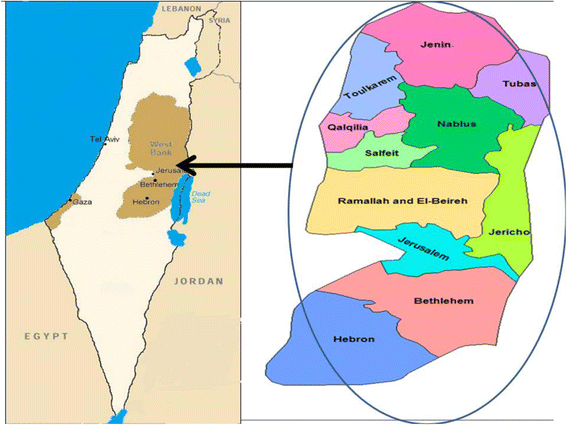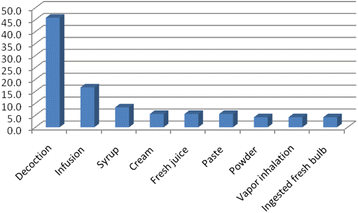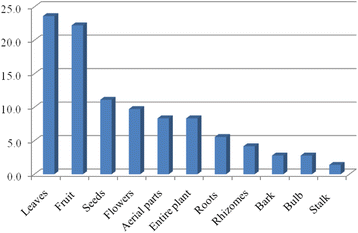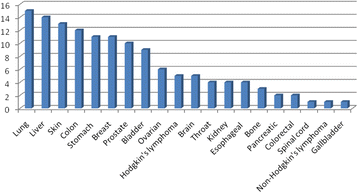Ethnopharmacological survey of herbal remedies used for treatment of various types of cancer and their methods of preparations in the West Bank-Palestine
- PMID: 26955822
- PMCID: PMC4784411
- DOI: 10.1186/s12906-016-1070-8
Ethnopharmacological survey of herbal remedies used for treatment of various types of cancer and their methods of preparations in the West Bank-Palestine
Abstract
Background: Plants have been the primary source of medicines since life on earth; more than 50 % of existing cancer treatments are derived from plants.
Methods: An ethnopharmacological survey of herbal remedies used in cancer treatment was carried out in the West Bank/ Palestine. A questionnaire was distributed to one hundred and fifty herbalists, traditional healers and rural dwellers. Collected information included the names of plants, the used parts, types of cancers for which these plants were used and also their methods of preparation. To identify the most important species used, Factor of informant's consensus (F(ic)), Fidelity level (Fl) and the Use-value (UV) were calculated.
Results: Collected data has shown that 72 plants are utilized for treatment of cancer, belonging to 44 families; from them Compositae and Lamiaceae were the most common. Leaves and fruits were the most commonly used parts, while decoctions, infusions and syrups were the main methods of preparation. Lung cancer was the most common type of cancer treated with these plants and Ephedra alata was the most commonly used plant for treatment of cancer in Palestine. The Fic was high for all the plants; Fl was 100% for many plants, the highest UV (0.72) was for Ephedra alata.
Conclusions: This study showed that many herbal remedies are still used by herbalists in Palestine for treatment of cancer; some of them have been approved scientifically while others are not. A combined effort between informants and scientific institutions working in this field can help in the discovery of new anticancer agents. Moreover, scientists must explore the most suitable method of extraction, formulation and dose determination in order to achieve the best benefits from these herbals.
Figures
Similar articles
-
Ethnopharmacological survey of home remedies used for treatment of hair and scalp and their methods of preparation in the West Bank-Palestine.BMC Complement Altern Med. 2017 Jul 5;17(1):355. doi: 10.1186/s12906-017-1858-1. BMC Complement Altern Med. 2017. PMID: 28679382 Free PMC article.
-
Ethnopharmacological survey about medicinal plants utilized by herbalists and traditional practitioner healers for treatments of diarrhea in the West Bank/Palestine.J Ethnopharmacol. 2016 Apr 22;182:57-66. doi: 10.1016/j.jep.2016.02.013. Epub 2016 Feb 13. J Ethnopharmacol. 2016. PMID: 26883246
-
Herbal remedies use by breast cancer patients in the West Bank of Palestine.J Ethnopharmacol. 2016 Feb 3;178:1-8. doi: 10.1016/j.jep.2015.11.050. Epub 2015 Dec 4. J Ethnopharmacol. 2016. PMID: 26656536
-
Herbal Arsenal against Skin Ailments: A Review Supported by In Silico Molecular Docking Studies.Molecules. 2022 Sep 21;27(19):6207. doi: 10.3390/molecules27196207. Molecules. 2022. PMID: 36234737 Free PMC article. Review.
-
Celtic Provenance in Traditional Herbal Medicine of Medieval Wales and Classical Antiquity.Front Pharmacol. 2020 Feb 28;11:105. doi: 10.3389/fphar.2020.00105. eCollection 2020. Front Pharmacol. 2020. PMID: 32184721 Free PMC article. Review.
Cited by
-
Assessing the therapeutic potential and safety of traditional anti-obesity herbal blends in Palestine.Sci Rep. 2024 Jan 22;14(1):1919. doi: 10.1038/s41598-024-52172-7. Sci Rep. 2024. PMID: 38253703 Free PMC article.
-
Anti-microbial and anti-cancer efficacy of acetone extract of Rosa chinensis against resistant strain and lung cancer cell line.BMC Complement Med Ther. 2023 Nov 10;23(1):406. doi: 10.1186/s12906-023-04222-2. BMC Complement Med Ther. 2023. PMID: 37950173 Free PMC article.
-
Topical aqueous extract of Ephedra alata can improve wound healing in an animal model.Chin J Traumatol. 2017 Apr;20(2):108-113. doi: 10.1016/j.cjtee.2016.10.004. Epub 2017 Jan 20. Chin J Traumatol. 2017. PMID: 28209447 Free PMC article.
-
Ethnopharmacological survey of home remedies used for treatment of hair and scalp and their methods of preparation in the West Bank-Palestine.BMC Complement Altern Med. 2017 Jul 5;17(1):355. doi: 10.1186/s12906-017-1858-1. BMC Complement Altern Med. 2017. PMID: 28679382 Free PMC article.
-
The use of complementary and alternative medicine among surgical patients: a cross-sectional study.Perioper Med (Lond). 2024 Nov 12;13(1):110. doi: 10.1186/s13741-024-00468-7. Perioper Med (Lond). 2024. PMID: 39533447 Free PMC article.
References
-
- Mendelssohn H, Yom-Tov Y. Mammalia of Israel. Fauna Palaestina. Israel Academy of Sciences: Jerusalem; 1999.
-
- Ben-Arye E, Samuels N. Homeopathy on the crossroads of traditional and integrative medicine in the Middle-East. J Med Person. 2015;13:65–71. doi: 10.1007/s12682-014-0196-z. - DOI
MeSH terms
Substances
LinkOut - more resources
Full Text Sources
Other Literature Sources
Medical





